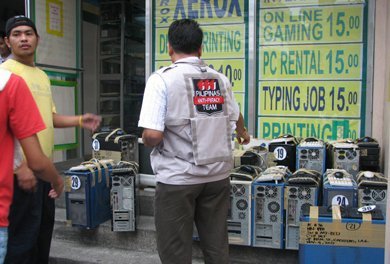What Must Happen On Legal Raid of an I-Café?

According to Supreme Court Circular A.M. No. 02-1-06-SC, the following steps must followed in the conduct of an anti-piracy search and seizure proceedings by government agencies implementing the Intellectual Property Code of the Philippines:
- Before such search and seizure (commonly called “raid“) of documents and articles in an i-café suspected of violating the intellectual property rights of a patent and/or copyright holder, the intellectual property holder or his duly-authorized representative must first secure a writ of search and seizure in accordance with Section Nos. 5 to 9 of the above-mentioned Supreme Court Circular. The posting of cash or surety bond of reasonable amount sufficient to pay for the damages that the i-café owner may incur in case the accuser or IPR holder loses the case is also provided in the circular.
- During the raid, the writ of search and seizure must be served on the alleged infringing i-café owner, his agent or representative or to person in control of the premises who must be given the chance to read the writ before its enforcement. The head of the raiding team called Commissioner in the circular must be a lawyer and he shall supervise the procedure of the search and seizure to be done by the sheriff. The whole procedure of the search and seizure is covered by Section Nos. 10 to 16 of the circular. It must be noted that Section 16 provides that only the computer disks and other storage devices can be seized by the raiding team unless those items cannot be readily removed, in which case the computer unit can be taken.
- After the raid, the sheriff must return the writ (this means submit a report) within three (3) days. Within the same period, the i-café owner may file a motion to discharge the writ requesting for the return of the seized item on grounds specified in Section 18 of the circular. The procedures that must happen after the raid including the remedies available to allegedly adverse i-café owner are covered by Section Nos. 17 to 20 of the circular.
- The filing of the case, its hearing and subsequent judgment are in Section Nos. 21 to 25 of the Supreme Court Circular A.M. No. 02-1-06-SC.
The above summary of procedures are normally done on raids conducted by the Pilipinas Anti-Piracy Team (PAPT). OMB’s procedure is somewhat different and I will write about it in my next blog.




complete and informative as usual. ^^
nothing left for me to say but, “waiting for your next posts!”